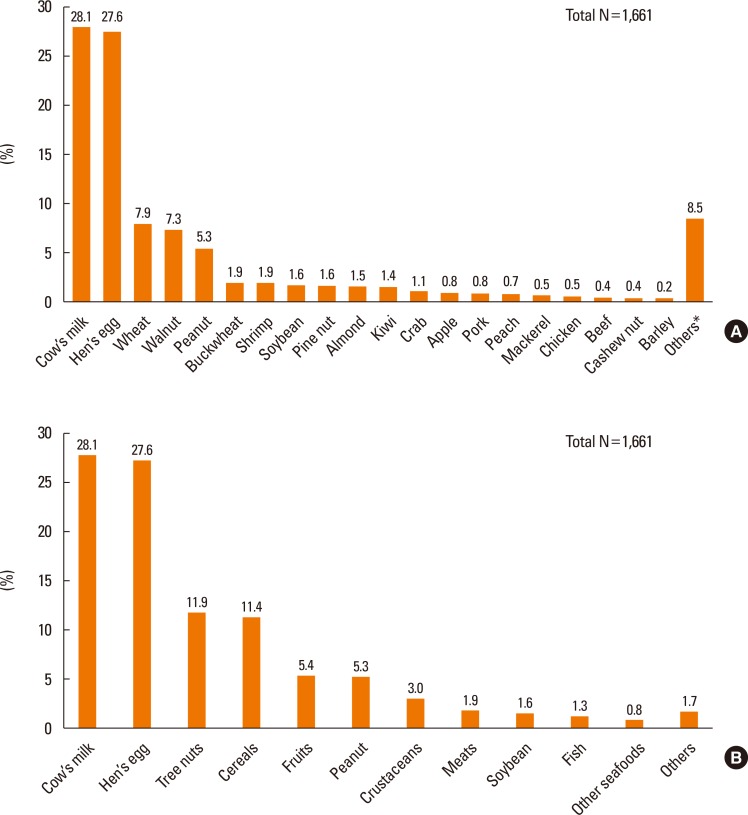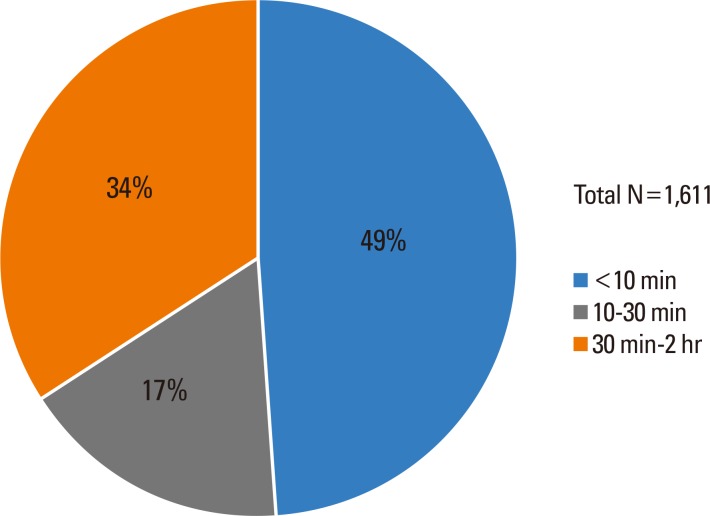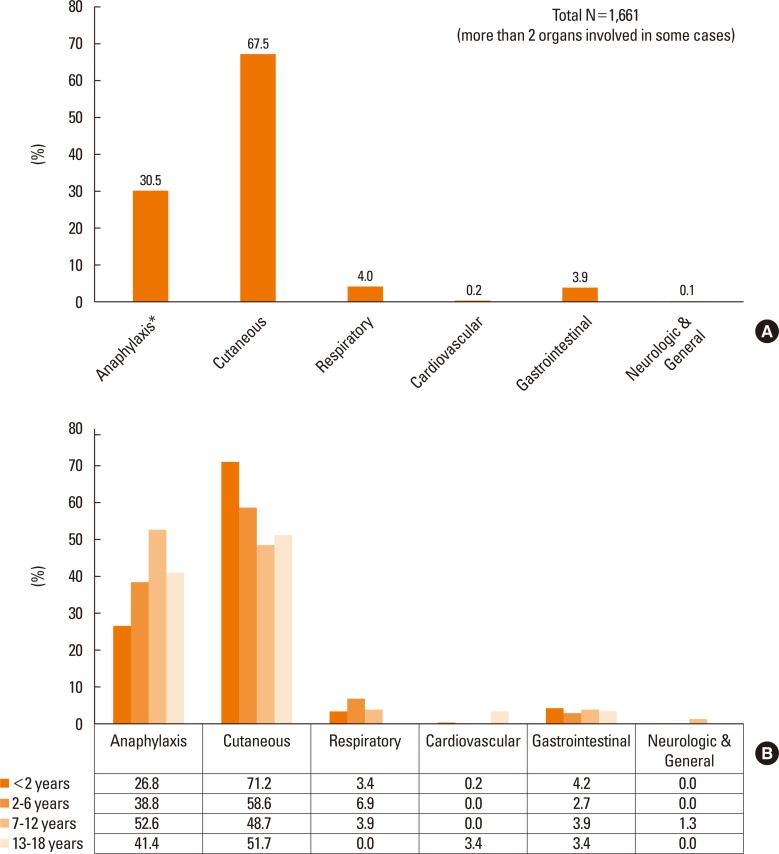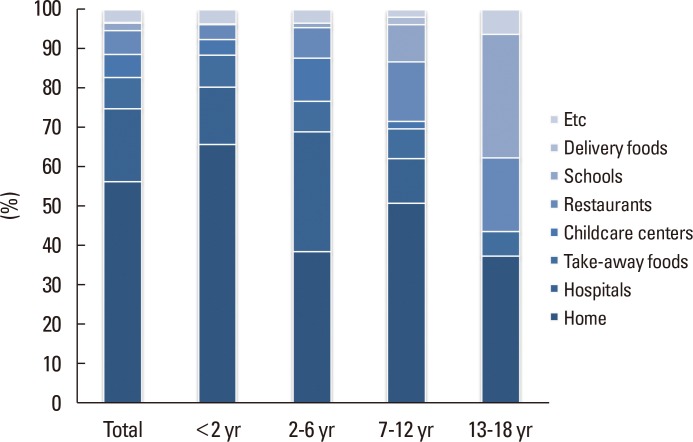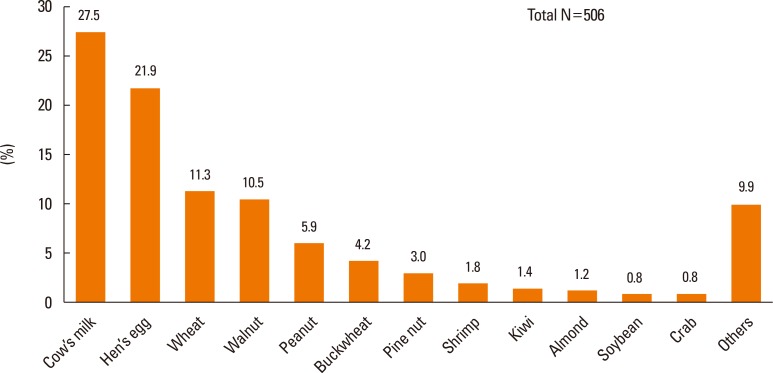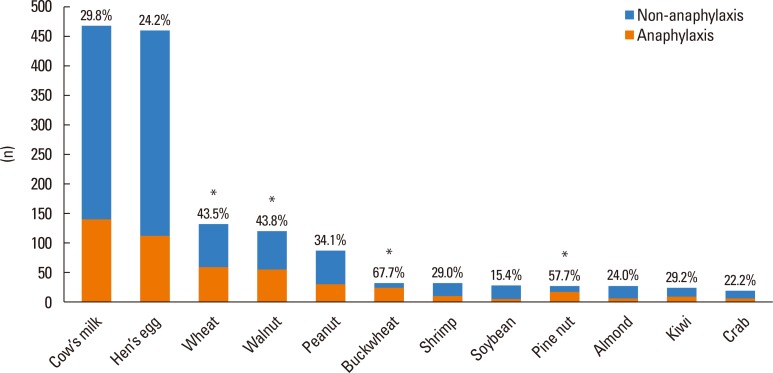Age-Based Causes and Clinical Characteristics of Immediate-Type Food Allergy in Korean Children
- Affiliations
-
- 1Department of Pediatrics, Ajou University School of Medicine, Suwon, Korea. jsjs87@ajou.ac.kr
- 2Department of Pediatrics, Samsung Medical Center, Sungkyunkwan University School of Medicine, Seoul, Korea.
- 3Department of Pediatrics, Hallym University Sacred Heart Hospital, Hallym University College of Medicine, Anyang, Korea.
- 4Department of Pediatrics, Soonchunhyang University Hospital, Seoul, Korea.
- 5Department of Pediatrics, Severance Hospital, Institute of Allergy, Yonsei University College of Medicine, Seoul, Korea.
- 6Department of Pediatrics, National Health Insurance Corporation Ilsan Hospital, Goyang, Korea.
- 7Department of Pediatrics, Inje University Ilsan Paik Hospital, Inje University College of Medicine, Goyang, Korea.
- 8Department of Pediatrics, Inha University Hospital, Incheon, Korea.
- 9Department of Pediatrics, Hallym University Dongtan Sacred Heart Hospital, Hallym University College of Medicine, Hwaseong, Korea.
- 10Department of Pediatrics, Hallym University Kangnam Sacred Heart Hospital, Hallym University College of Medicine, Seoul, Korea.
- 11Department of Pediatrics, Konkuk University School of Medicine, Seoul, Korea.
- 12Department of Pediatrics, Atopy Clinic, Seoul Medical Center, Seoul, Korea.
- 13Department of Pediatrics, The Catholic University of Korea, Uijeongbu St. Mary's Hospital, The Catholic University of Korea College of Medicine, Uijeongbu, Korea.
- 14Department of Pediatrics, Inje University Seoul Paik Hospital, Inje University College of Medicine, Seoul, Korea.
- KMID: 2383990
- DOI: http://doi.org/10.4168/aair.2017.9.5.423
Abstract
- PURPOSE
Age-based causes and clinical characteristics of immediate-type food allergy (FA) have not been sufficiently studied. Therefore, we investigated age-dependent clinical profiles of FA in Korean children through an extensive multicenter investigation.
METHODS
Using a case report form developed by the authors, a retrospective medical record review was performed of patients (0-18 years old) diagnosed with immediate-type FA between September 2014 and August 2015 in 14 tertiary hospitals in Korea.
RESULTS
A total of 1,353 children and adolescents, 93% younger than 7 years, were enrolled in the present study, and 1,661 cases of immediate-type FA were recorded in these patients. The 7 major causative foods were cow's milk (28.1%), hen's eggs (27.6%), wheat (7.9%), walnuts (7.3%), peanuts (5.3%), buckwheat (1.9%), and shrimps (1.9%). Categorizing the patients into 4 age groups revealed that the most common causative food was different for each age group: cow's milk (<2 years), walnuts (2-6 years), walnuts (7-12 years), and buckwheat (13-18 years). The onset time of symptoms was less than 10 minutes in 49%, between 10 and 30 minutes in 17%, and between 30 minutes and 2 hours in 34% of cases. Food-induced anaphylaxis was reported in 506 (30.5%) out of 1,661 cases, and the 7 major causes of food-induced anaphylaxis was cow's milk (27.5%), hen's eggs (21.9%), wheat (11.3%), walnuts (10.5%), peanuts (5.9%), buckwheat (4.2%), and pine nuts (3.0%). The proportion of anaphylaxis was highest in the patients allergic to buckwheat (67.7%), followed by those allergic to pine nuts (57.7%), walnuts (43.8%), wheat (43.5%), and peanuts (34.1%).
CONCLUSIONS
The 5 major causative foods of immediate-type FA in Korean children were cow's milk, hen's eggs, wheat, walnuts, and peanuts. The distribution of causative foods was considerably distinctive according to different age groups. Anaphylaxis was reported in 30.5% of immediate-type FA cases.
Keyword
MeSH Terms
Figure
Cited by 13 articles
-
Clinical and Laboratory Findings of Barley Allergy in Korean Children: a Single Hospital Based Retrospective Study
Eunjoo Lee, Kyunguk Jeong, Jeongmin Lee, Se-Ah Jeon, Bumhee Park, Heirim Lee, Sooyoung Lee
J Korean Med Sci. 2020;35(3):. doi: 10.3346/jkms.2020.35.e23.Clinical and Laboratory Predictors of Egg Allergy Resolution in Children
Jeong Hee Kim
Allergy Asthma Immunol Res. 2019;11(4):446-449. doi: 10.4168/aair.2019.11.4.446.The past, present, and future of the research on food allergy in Korean children
Kangmo Ahn
Allergy Asthma Respir Dis. 2018;6(Suppl 1):S44-S51. doi: 10.4168/aard.2018.6.S1.S44.The past, present, and future of research on anaphylaxis in Korean children
Sooyoung Lee
Allergy Asthma Respir Dis. 2018;6(Suppl 1):S21-S30. doi: 10.4168/aard.2018.6.S1.S21.Asia Pacific Allergy: A great platform for allergy
Yoon-Seok Chang
Asia Pac Allergy. 2018;8(4):. doi: 10.5415/apallergy.2018.8.e42.Risk factors for food allergy among children in Seoul: focusing on dietary habits and environmental factors
Mijung Jang, KyooSang Kim
J Nutr Health. 2019;52(6):559-568. doi: 10.4163/jnh.2019.52.6.559.Is There Any Necessity to Prescribe Consumption of Walnuts Cooked by Different Processing Techniques to Patients With Walnut Allergy?
Jae-Won Oh
Allergy Asthma Immunol Res. 2018;10(4):287-289. doi: 10.4168/aair.2018.10.4.287.Immunoglobulin E-binding Proteins of Cooked Walnuts in Korean Children
Jeongmin Lee, Kyunguk Jeong, Se-ah Jeon, Sooyoung Lee
Allergy Asthma Immunol Res. 2018;10(4):363-369. doi: 10.4168/aair.2018.10.4.363.How Different Parts of the World Provide New Insights Into Food Allergy
Elizabeth Huiwen Tham, Donald Y.M. Leung
Allergy Asthma Immunol Res. 2018;10(4):290-299. doi: 10.4168/aair.2018.10.4.290.Clinical characteristics and causative food types of immediate-type cow’ s milk and egg white allergy in children
Eunjoo Lee, Kyunguk Jeong, Ji Young Lee, Taek Ki Min, Minji Kim, Hea-Kyoung Yang, Hae Won Lee, Jihyun Kim, Kangmo Ahn, Bok Yang Pyun, Sooyoung Lee
Allergy Asthma Respir Dis. 2017;5(6):351-357. doi: 10.4168/aard.2017.5.6.351.Epidemiology of food allergy in Korean children
Taek Ki Min, Bok Yang Pyun, Hyun Hee Kim, Yong-Mean Park, Gwang Cheon Jang, Hye-Young Kim, Hye Yung Yum, Jihyun Kim, Kangmo Ahn, Sooyoung Lee, Kyung Won Kim, Yoon Hee Kim, Jeong-Min Lee, Woo Kyung Kim, Tae Won Song, Jeong Hee Kim, Yong Ju Lee, You Hoon Jeon, So-Yeon Lee
Allergy Asthma Respir Dis. 2018;6(1):4-13. doi: 10.4168/aard.2018.6.1.4.The current status and issue of food allergen labeling in Korea
You Hoon Jeon, Hyun Hee Kim, Yong Mean Park, Gwang Cheon Jang, Hye-Young Kim, Hye Yung Yum, Jihyun Kim, Kangmo Ahn, Taek Ki Min, Bok Yang Pyun, Sooyoung Lee, Kyung Won Kim, Yoon Hee Kim, Jeongmin Lee, So-Yeon Lee, Woo Kyung Kim, Tae Won Song, Jeong Hee Kim, Yong Ju Lee
Allergy Asthma Respir Dis. 2019;7(2):67-72. doi: 10.4168/aard.2019.7.2.67.Development of a semi-quantitative food frequency questionnaire for dietary intake of elementary school children: data from the Seventh Korea National Health and Nutrition Examination Survey
Minji Jung, Eunhee Ha, Oran Kwon, Hyesook Kim
Nutr Res Pract. 2023;17(4):747-761. doi: 10.4162/nrp.2023.17.4.747.
Reference
-
1. Longo G, Berti I, Burks AW, Krauss B, Barbi E. IgE-mediated food allergy in children. Lancet. 2013; 382:1656–1664. PMID: 23845860.
Article2. Sánchez-García S, Cipriani F, Ricci G. Food allergy in childhood: phenotypes, prevention and treatment. Pediatr Allergy Immunol. 2015; 26:711–720. PMID: 26595763.
Article3. Gupta RS, Springston EE, Warrier MR, Smith B, Kumar R, Pongracic J, et al. The prevalence, severity, and distribution of childhood food allergy in the United States. Pediatrics. 2011; 128:e9–e17. PMID: 21690110.
Article4. Rona RJ, Keil T, Summers C, Gislason D, Zuidmeer L, Sodergren E, et al. The prevalence of food allergy: a meta-analysis. J Allergy Clin Immunol. 2007; 120:638–646. PMID: 17628647.
Article5. Soller L, Ben-Shoshan M, Harrington DW, Fragapane J, Joseph L, St Pierre Y, et al. Overall prevalence of self-reported food allergy in Canada. J Allergy Clin Immunol. 2012; 130:986–988. PMID: 22867693.
Article6. Johnson J, Malinovschi A, Alving K, Lidholm J, Borres MP, Nordvall L. Ten-year review reveals changing trends and severity of allergic reactions to nuts and other foods. Acta Paediatr. 2014; 103:862–867. PMID: 24825328.
Article7. Park M, Kim D, Ahn K, Kim J, Han Y. Prevalence of immediate-type food allergy in early childhood in Seoul. Allergy Asthma Immunol Res. 2014; 6:131–136. PMID: 24587949.
Article8. Flokstra-de Blok BM, Dubois AE, Vlieg-Boerstra BJ, Oude Elberink JN, Raat H, DunnGalvin A, et al. Health-related quality of life of food allergic patients: comparison with the general population and other diseases. Allergy. 2010; 65:238–244. PMID: 19796214.
Article9. Hill DA, Grundmeier RW, Ram G, Spergel JM. The epidemiologic characteristics of healthcare provider-diagnosed eczema, asthma, allergic rhinitis, and food allergy in children: a retrospective cohort study. BMC Pediatr. 2016; 16:133. PMID: 27542726.
Article10. Nowak-Wegrzyn A, Sampson HA. Adverse reactions to foods. Med Clin North Am. 2006; 90:97–127. PMID: 16310526.
Article11. Sampson HA, Muñoz-Furlong A, Campbell RL, Adkinson NF Jr, Bock SA, Branum A, et al. Second symposium on the definition and management of anaphylaxis: summary report--Second National Institute of Allergy and Infectious Disease/Food Allergy and Anaphylaxis Network symposium. J Allergy Clin Immunol. 2006; 117:391–397. PMID: 16461139.
Article12. Akiyama H, Imai T, Ebisawa M. Japan food allergen labeling regulation--history and evaluation. Adv Food Nutr Res. 2011; 62:139–171. PMID: 21504823.
Article13. Crespo JF, Pascual C, Burks AW, Helm RM, Esteban MM. Frequency of food allergy in a pediatric population from Spain. Pediatr Allergy Immunol. 1995; 6:39–43. PMID: 7550764.
Article14. Imamura T, Kanagawa Y, Ebisawa M. A survey of patients with self-reported severe food allergies in Japan. Pediatr Allergy Immunol. 2008; 19:270–274. PMID: 18397411.
Article15. Ferrari GG, Eng PA. IgE-mediated food allergies in Swiss infants and children. Swiss Med Wkly. 2011; 141:w13269. PMID: 21990006.
Article16. Namork E, Fæste CK, Stensby BA, Egaas E, Løvik M. Severe allergic reactions to food in Norway: a ten year survey of cases reported to the food allergy register. Int J Environ Res Public Health. 2011; 8:3144–3155. PMID: 21909296.
Article17. Mäkinen-Kiljunen S, Haahtela T. Eight years of severe allergic reactions in Finland: a register-based report. World Allergy Organ J. 2008; 1:184–189. PMID: 23282762.18. Chen W, Mempel M, Schober W, Behrendt H, Ring J. Gender difference, sex hormones, and immediate type hypersensitivity reactions. Allergy. 2008; 63:1418–1427. PMID: 18925878.
Article19. Uekert SJ, Akan G, Evans MD, Li Z, Roberg K, Tisler C, et al. Sex-related differences in immune development and the expression of atopy in early childhood. J Allergy Clin Immunol. 2006; 118:1375–1381. PMID: 17157669.
Article20. Pyrhönen K, Näyhä S, Kaila M, Hiltunen L, Läärä E. Occurrence of parent-reported food hypersensitivities and food allergies among children aged 1–4 yr. Pediatr Allergy Immunol. 2009; 20:328–338. PMID: 19538354.21. Kim HO, Cho SI, Kim JH, Chung BY, Cho HJ, Park CW, et al. Food hypersensitivity in patients with childhood atopic dermatitis in Korea. Ann Dermatol. 2013; 25:196–202. PMID: 23717011.
Article22. Sicherer SH, Muñoz-Furlong A, Godbold JH, Sampson HA. US prevalence of self-reported peanut, tree nut, and sesame allergy: 11-year follow-up. J Allergy Clin Immunol. 2010; 125:1322–1326. PMID: 20462634.
Article23. Mousan G, Kamat D. Cow’s milk protein allergy. Clin Pediatr (Phila). 2016; 55:1054–1063. PMID: 27582492.
Article24. Doğruel D, Bingöl G, Altıntaş DU, Yılmaz M, Güneşer Kendirli S. Clinical features of food allergy during the 1st year of life: the ADAPAR Birth Cohort Study. Int Arch Allergy Immunol. 2016; 169:171–180. PMID: 27105247.
Article25. Mehl A, Wahn U, Niggemann B. Anaphylactic reactions in children--a questionnaire-based survey in Germany. Allergy. 2005; 60:1440–1445. PMID: 16197479.26. de Silva IL, Mehr SS, Tey D, Tang ML. Paediatric anaphylaxis: a 5 year retrospective review. Allergy. 2008; 63:1071–1076. PMID: 18691309.27. Worm M, Moneret-Vautrin A, Scherer K, Lang R, Fernandez-Rivas M, Cardona V, et al. First European data from the network of severe allergic reactions (NORA). Allergy. 2014; 69:1397–1404. PMID: 24989080.
Article28. Sicherer SH, Furlong TJ, DeSimone J, Sampson HA. The US Peanut and Tree Nut Allergy Registry: characteristics of reactions in schools and day care. J Pediatr. 2001; 138:560–565. PMID: 11295721.
Article29. Muñoz-Furlong A, Weiss CC. Characteristics of food-allergic patients placing them at risk for a fatal anaphylactic episode. Curr Allergy Asthma Rep. 2009; 9:57–63. PMID: 19063826.
Article30. Gallagher M, Worth A, Cunningham-Burley S, Sheikh A. Strategies for living with the risk of anaphylaxis in adolescence: qualitative study of young people and their parents. Prim Care Respir J. 2012; 21:392–397. PMID: 22875142.
Article31. Imai T, Sugizaki C, Ebisawa M. A report on 2011 Nationwide Survey of Immediate Type Food Allergies in Japan (supported by a grant from “Consumer Affairs Agency, Government of Japan”). Arerugi. 2016; 65:942–946. PMID: 27545061.32. Grabenhenrich LB, Dölle S, Moneret-Vautrin A, Köhli A, Lange L, Spindler T, et al. Anaphylaxis in children and adolescents: the European Anaphylaxis Registry. J Allergy Clin Immunol. 2016; 137:1128–1137.e1. PMID: 26806049.
Article33. Lee SY, Ahn K, Kim J, Jang GC, Min TK, Yang HJ, et al. A multicenter retrospective case study of anaphylaxis triggers by age in Korean children. Allergy Asthma Immunol Res. 2016; 8:535–540. PMID: 27582405.
Article34. Lee SY. IgE mediated food allergy in Korean children: focused on plant food allergy. Asia Pac Allergy. 2013; 3:15–22. PMID: 23403730.
Article36. Park K, Jeong K, Lee S. Clinical and laboratory findings of childhood buckwheat allergy in a single tertiary hospital. Korean J Pediatr. 2016; 59:402–407. PMID: 27826326.
Article37. Finkelman FD. Peanut allergy and anaphylaxis. Curr Opin Immunol. 2010; 22:783–788. PMID: 21051210.
Article
- Full Text Links
- Actions
-
Cited
- CITED
-
- Close
- Share
- Similar articles
-
- Food Allergy-related Awareness and Performance of Dietitians at Children's Hospitals in Korea: Comparison of Certificate Possession among Clinical Dietitians
- The past, present, and future of the research on food allergy in Korean children
- Food Allergy: Diagnosis and Management
- The management of food allergy in Indonesia
- The Diagnosis of Food Allergy in a Pediatric Gastroenterology: Focusing on Non-IgE-mediated Allergic Diseases

